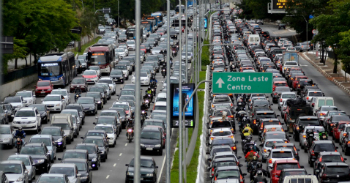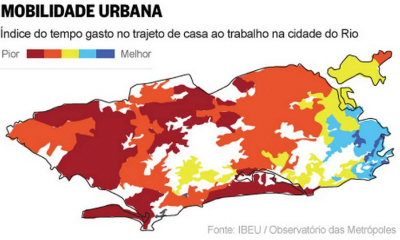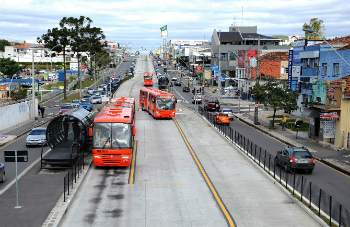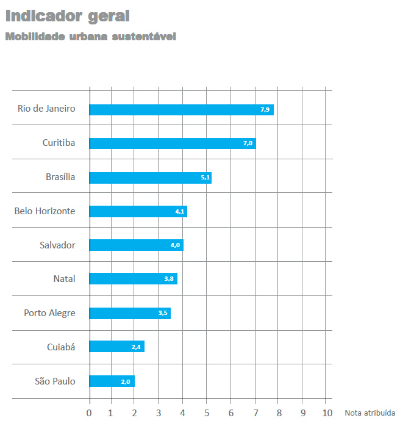Urban mobility it is the form and means used by the population to move within the urban space.
To assess urban mobility, factors such as:
- the organization of the territory;
- flow of transport of people and goods;
- the means of transport used.
History
Due to the large population index, in some Brazilian cities urban mobility is considered one of the main challenges in city management today.
The theme is the target of debates and criticism due to the option for individual motorized transport, which experts call the "car paradigm".
The automobile paradigm directly influenced the layout of cities that emerged in the 50s and 60s. The most notorious example, in the country, is the Brasilia construction whose displacement was entirely designed to be done by car.
Among the factors that demonstrate the failure of the privilege of individual motorized transport are traffic jams and environmental pollution. Today, these factors are common in the main Brazilian cities.
The Brazilian car fleet grew 400% in ten years, according to data from FGV (Fundação Getúlio Vargas), in a survey conducted in 2016.
The construction of alternative and collective transport, such as the surface subway, did not show the same rate of increase in the same period.
Data on urban mobility in Brazil
Currently, the cities that suffer the most from swelling in traffic are, respectively, São Paulo, Rio de Janeiro and Curitiba.
Sao Paulo

In the city of São Paulo, 5 million people travel daily by bus, while 4 million use the subway. The city has a fleet of nearly 7 million private vehicles.
One of the solutions found was the establishment of rotation between cars determined by the vehicle's license plate number.
However, the law was not effective. This is because some people have purchased a second car with a different number in order to continue using the private vehicle.
The city continues to invest in the expansion of the subway network to lessen the effects of chaotic traffic.
Rio de Janeiro

In Rio de Janeiro, 3 million people depend on the bus and 780 thousand on the subway.
However, with the World Cup (2010) and the Olympic Games (2014), many urban mobility projects came out of the paper and benefited citizens.
One of them was the construction of surface subways in the center of the city and also in areas further away from the center in order to make daily commuting faster.
Rio de Janeiro's main challenge continues to be the integration with the municipalities that are part of the so-called "Grande Rio".
River transport is used below its capacity due to the political and commercial interests of the different city halls that surround Rio de Janeiro.
Curitiba

In Curitiba, where there is no subway, 2 million people need to travel using buses.
In the 90s, the city was a pioneer:
- construction of exclusive bus lanes;
- platforms where the user paid the fee before entering;
- use of collective capacity to transport more than one hundred passengers.
However, the capital of Paraná grew, and the subway plan did not leave the paper. In this way, the city begins to experience traffic jams during off-peak hours.
read more:
Means of Transport
Brazilian Urban Network
Problems of urban mobility
Taking into account the option for individual motorized transport in our country, the main problems encountered are:
- Space overload;
- Flow limitation;
- Increased accident rate, resulting in serious mutilations or deaths;
- Small offer of mobility alternatives to serve the excess of passengers who depend on public transport;
- Environmental pollution.
The absence of specific policies to increase the supply of viable and efficient means of transport directly results in the search for individual transport.
The situation is driven by pressure from the automobile industry which, in addition to dividends, generates jobs in Brazil.
More cars on the streets, however, increase the number of traffic accidents, where most victims are at full productive capacity. There is also an increase in pressure on Social Security, in cases of death or permanent disability.
As for the environment, the increase in carbon dioxide in the atmosphere is the most visible consequence due to the residues of fossil fuels.
We must also take into account the noise pollution generated by the noise of car engines. Noise causes stress to the body, irritability and tiredness.
Also, there are materials that are no longer used. Every year, Brazil discards thousands of disused tires and parts, polluting rivers and conservation areas.
Sustainable urban mobility

The practice of sustainable urban mobility is already common, even in Brazil.
This concept depends on the political will to implement so-called rail vehicles, such as subways and surface trains. It also integrates the so-called clean buses – which use alternative fuel – cycle paths and moving walkways.
For cities that are not flat, cable cars, elevators and escalators can be built that allow quick movement without polluting the environment.
Likewise, the stimulation of the electric car would be an alternative. After all, it is moved through renewable energy and it doesn't even make noise.
In addition to motor transport, sustainable urban mobility must pay attention to the comfort of those who prefer to move on foot.
Therefore, sidewalks must be in good conditions for pedestrians, wheelchair users, the visually impaired and people with temporary or permanent reduced mobility.
Read too Sustainable city.
urban mobility law
In 2012, the Urban Mobility Law was enacted, which must be applied in municipalities with more than 20,000 inhabitants.
The law requires municipalities to prepare an urban mobility plan that aims to:
- improve the movement of people around the city;
- integrate the different means of transport;
- to establish an affordable price for their tariffs.
The deadline was January 2015 and by that date only 5% of the city halls had delivered the plan. Thus, it was established that cities could present their projects until April 2018.
Even so, the law was hailed by experts as a step forward between political power and civil society. In addition, it forces municipalities to work with long-term planning and issues.
Challenges of urban mobility

The challenges for improving urban mobility are diverse and meet local specificities. However, we can mention some common points:
- improving public transport;
- replacement of fossil energy with clean energy;
- construction of cycle paths and cycle lanes;
- lower taxes for those who want to purchase an electric car;
- integration of means of transport through single and complementary tickets.
read more:
- Megacities
- urban geography
- Metropolis and Megalopolis
- urban hierarchy
- What are Metropolitan Regions?
- Urban mobility: the steps for an Enem grade 1000 essay

